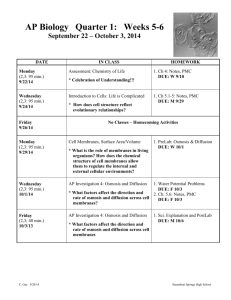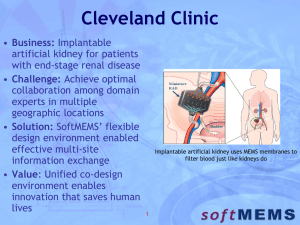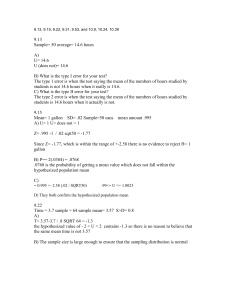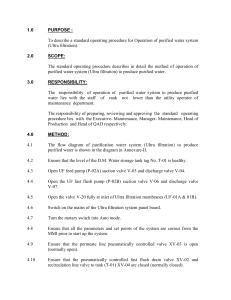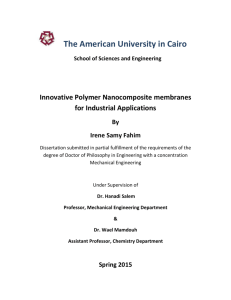Reverse Osmosis system checklist
advertisement
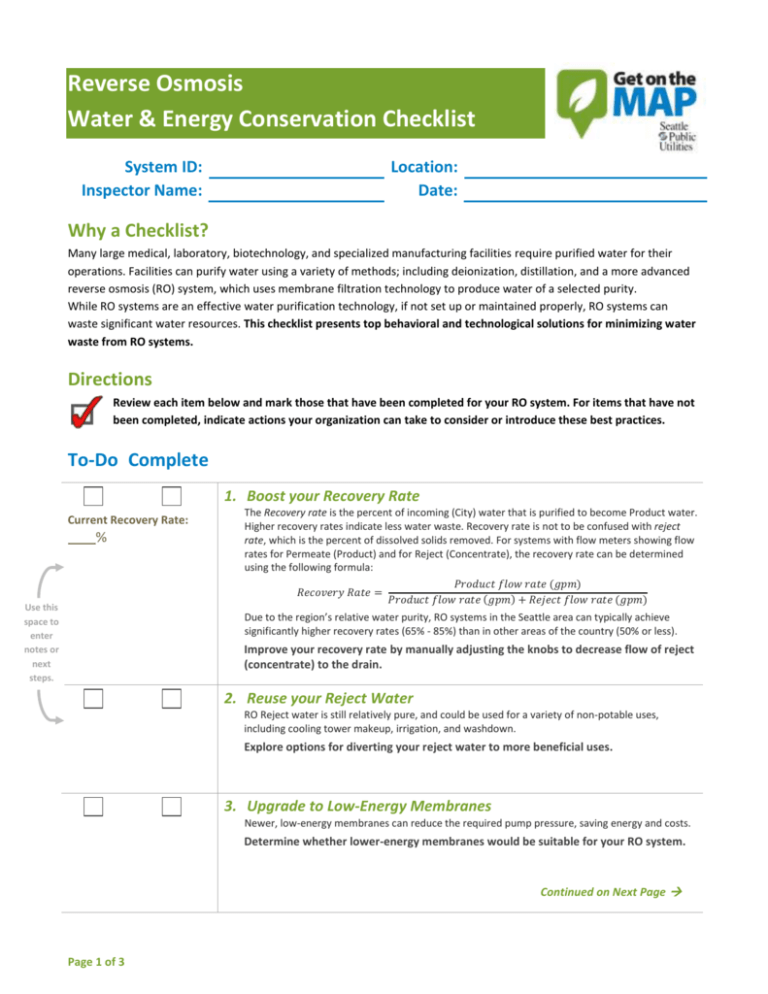
Reverse Osmosis Water & Energy Conservation Checklist System ID: Inspector Name: Location: Date: Why a Checklist? Many large medical, laboratory, biotechnology, and specialized manufacturing facilities require purified water for their operations. Facilities can purify water using a variety of methods; including deionization, distillation, and a more advanced reverse osmosis (RO) system, which uses membrane filtration technology to produce water of a selected purity. While RO systems are an effective water purification technology, if not set up or maintained properly, RO systems can waste significant water resources. This checklist presents top behavioral and technological solutions for minimizing water waste from RO systems. Directions Review each item below and mark those that have been completed for your RO system. For items that have not been completed, indicate actions your organization can take to consider or introduce these best practices. To-Do Complete 1. Boost your Recovery Rate Current Recovery Rate: % Use this space to enter notes or next steps. The Recovery rate is the percent of incoming (City) water that is purified to become Product water. Higher recovery rates indicate less water waste. Recovery rate is not to be confused with reject rate, which is the percent of dissolved solids removed. For systems with flow meters showing flow rates for Permeate (Product) and for Reject (Concentrate), the recovery rate can be determined using the following formula: 𝑃𝑟𝑜𝑑𝑢𝑐𝑡 𝑓𝑙𝑜𝑤 𝑟𝑎𝑡𝑒 (𝑔𝑝𝑚) 𝑅𝑒𝑐𝑜𝑣𝑒𝑟𝑦 𝑅𝑎𝑡𝑒 = 𝑃𝑟𝑜𝑑𝑢𝑐𝑡 𝑓𝑙𝑜𝑤 𝑟𝑎𝑡𝑒 (𝑔𝑝𝑚) + 𝑅𝑒𝑗𝑒𝑐𝑡 𝑓𝑙𝑜𝑤 𝑟𝑎𝑡𝑒 (𝑔𝑝𝑚) Due to the region’s relative water purity, RO systems in the Seattle area can typically achieve significantly higher recovery rates (65% - 85%) than in other areas of the country (50% or less). Improve your recovery rate by manually adjusting the knobs to decrease flow of reject (concentrate) to the drain. 2. Reuse your Reject Water RO Reject water is still relatively pure, and could be used for a variety of non-potable uses, including cooling tower makeup, irrigation, and washdown. Explore options for diverting your reject water to more beneficial uses. 3. Upgrade to Low-Energy Membranes Newer, low-energy membranes can reduce the required pump pressure, saving energy and costs. Determine whether lower-energy membranes would be suitable for your RO system. Continued on Next Page Page 1 of 3 RO Water & Energy Conservation Checklist, Cont’d. To-Do Complete 4. Consider Contracting for Off-Site DI Service Instead of On-Site Regeneration For larger RO systems, contracting for off-site regeneration of ion exchange canisters can be a cost effective means to reduce both water and sewer use. Explore available off-site ion exchange solutions for your RO system. 5. Minimize End-Use Demand and Waste For every gallon of pure water use avoided, a gallon of reject water is also saved (exact amount depending on recovery rate). Actions to reduce the use and waste of purified water can pay significant dividends for water conservation. There are many ways in which RO system use can result in excess water waste. Many processes use purified water when City water may suffice, or may use RO water for multiple rinses when only the final rinse is needed. Additionally, users may run purified-water faucets unnecessarily or rinse for longer periods than needed. Work with employees to ensure that they understand the full costs and appropriate uses of purified water. Install conductivity sensors on glass washers to minimize overrinsing. Ensure glass washers are programmed to use only one RO final rinse. 6. Size your System and Storage Tank Appropriately Over-sized systems use more expensive membranes and require more flushing upon start-up, resulting in higher membrane replacement costs and reduced water quality. Right-size your RO system to best match your purified water needs. 7. Maximize Cycle Time Current Cycle Time: Between each operating cycle, unpressurized water in the membranes can leach contaminants to the pure-water side of the membrane, resulting in forward osmosis. This process produces an initial flow of lower quality product water at system start-up. Longer cycle times (at least 30 minutes) result in fewer startups, minimizing forward osmosis and improving overall water quality. Set the fill and stop set points on the pure water storage tank far enough apart to allow for maximum cycle times. 8. Adjust the Product Diversion Valve For systems with high water-quality requirements, contamination from forward osmosis may be minimized through diversion of initial product water to the drain. Although this diversion benefits the water quality, diversion for longer than necessary can waste water. If your system has a Product Diversion Valve, ensure that it is not open for longer than necessary. Continued on Next Page Page 2 of 3 RO Water & Energy Conservation Checklist, Cont’d. To-Do Complete 9. Consider Adding a Second Stage or Additional Membranes Adding a second stage to your RO system can reclaim water from the reject stream and greatly increase your overall recovery rate. Installation of additional membranes can produce the same effect, increasing existing system capacity and recovery rate. Explore how adding a second stage or additional membranes may improve your recovery rate. 10. Optimize Sanitation Procedures for Pure Water Distribution Loop Optimizing your sanitation procedures for the pure water piping loop can save you both time and money. Remove any dead legs in your piping system. When possible, completely drain holding tank, UV housing, and filter housing one section at a time. Add drain valves as necessary. Contact Us! For more ways to save on your utility bills –and get recognized for your efforts– visit www.seattle.gov/getonthemap or contact the Seattle Public Utilities’ Green Business Program at (206) 343-8505 or greenbusiness@seattle.gov. Page 3 of 3
